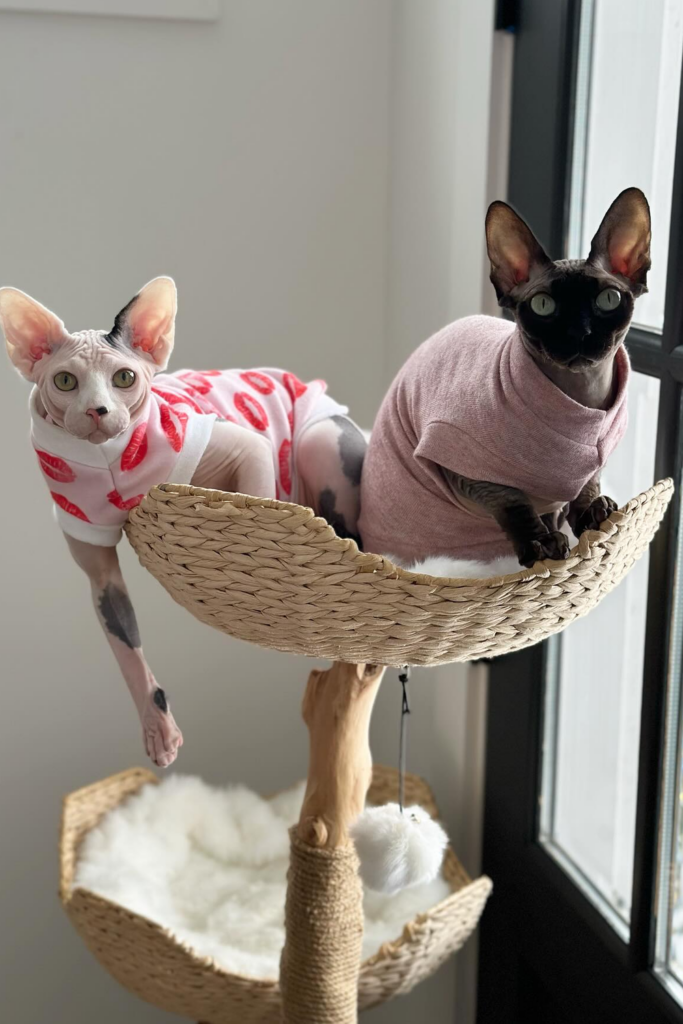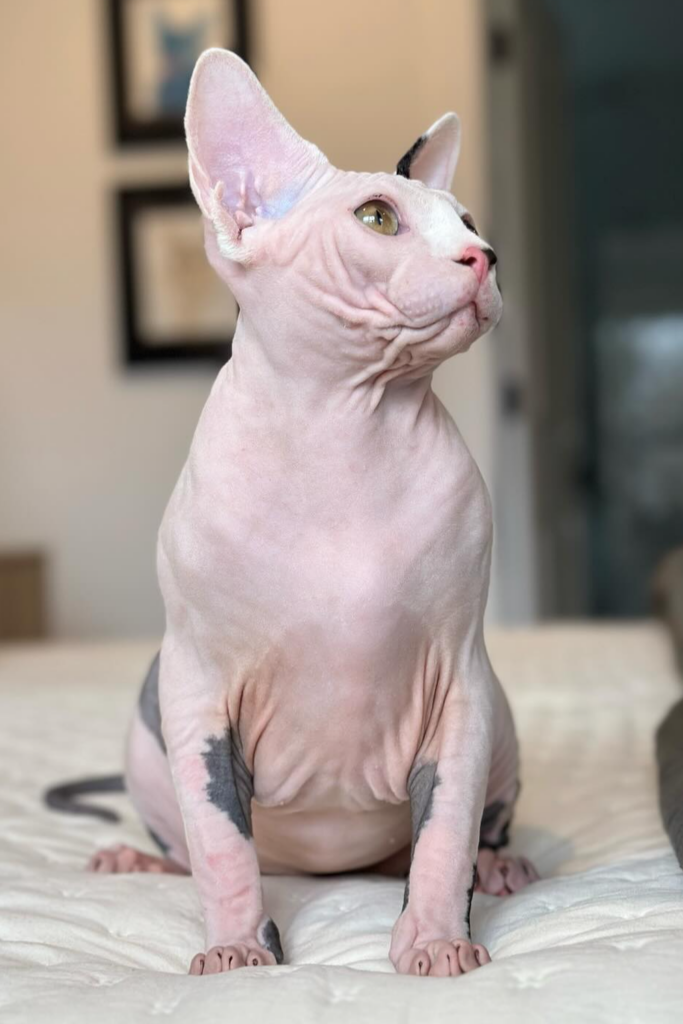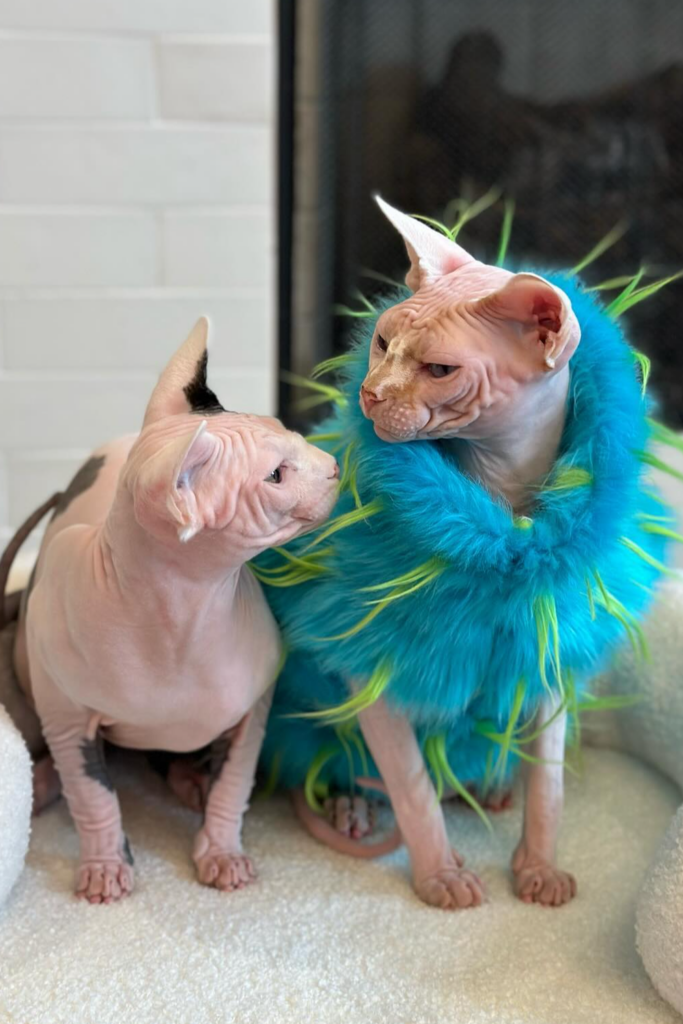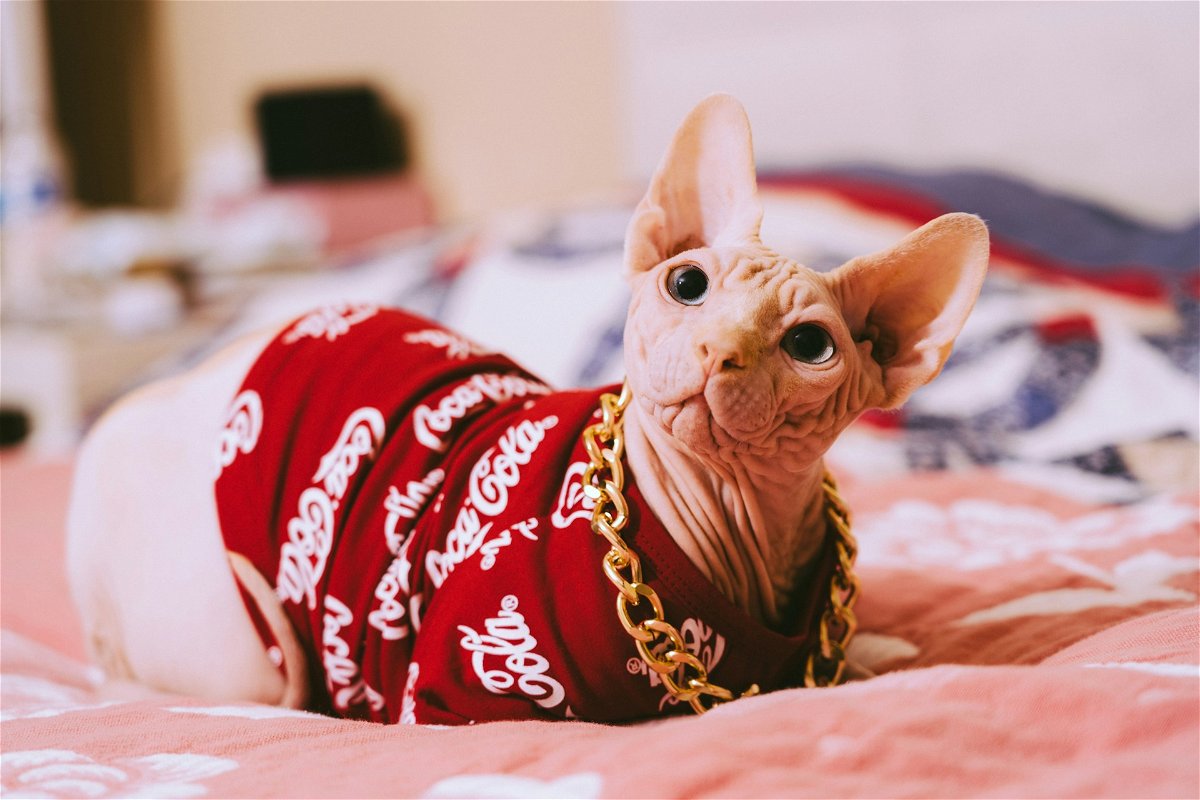We're an affiliate
We hope you love the products we recommend! Just so you know, we may collect a share of sales or other compensation from the links on this page at no additional cost to you. Thank you if you use our links, we really appreciate it!
When seeing a Sphynx cat for the first time, you may be shocked at how their exterior look differs from the average fluffy feline.
With their wrinkled skin, large ears, and lack of fur coat, Sphynx cats are undeniably one of the most unique feline breeds.
These felines are highly priced for their social nature and fun side. In this guide, we’ll walk through all you need to know about Sphynx cats to keep you informed before adopting one.
All You Need to Know About Sphynx Cats – A Quick Overview
| Official Name | Sphynx |
| Other Names | Canadian Hairless, Canadian Sphynx |
| Origin | Canada (1960s) |
| Size | Medium |
| Length | About 13 -15 inches from head to tail |
| Weight | 7 -14 pounds |
| Coat | Very short and fine down with a suede-like texture |
| Coat Pattern | Can occur in any feline pattern (tabby, solid, tortoiseshell, etc.) |
| Shedding | Minimal, but not non-existent |
| Colors | White, black, brown, red, and many other colors and patterns |
| Eye Color | All possible feline eye colors |
| Lifespan | 8 -14 years |
| Grooming Needs | High – Frequent baths, ear cleaning, wrinkle care |
| Social Needs | Very high – Crave companionship |
| Energy Level | Medium to High |
| Vocal Level | High |
| Temperament | Affectionate, playful, intelligent, curious, social |
| Exercise Needs | Low |
Sphynx Cat Breed History
In 1966, a domestic shorthaired cat, named Elizabeth, surprised her owners in Toronto, Canada by giving birth to a hairless kitten named Prune, among others in the litter.
Prune was backcrossed with her mother and they birthed one more bald-like kitten in the litter. This genetic mutation sparked interest among breeders, who set the foundation for Sphynxes.
Originally called ‘the Canadian Hairless’, the Sphynx cats soon spread across the border. Both American and Canadian breeders worked tirelessly to refine this unique cat breed.

They also crossed these hairless kittens with the Devon Rex, another breed known with a sparse coat, to strengthen the gene pool of hairless kittens.
With dedication and continuity in breeding, the Sphynx cat grew to become an officially recognized feline breed with its own distinct set of breeding standards.
The Sphynx breed is recognized by major cat associations, including The International Cat Association (2005), the Cat Fanciers Association (2002), and other European cat clubs.
Sphynx breed standards can vary slightly between these organizations. The American Cat Fanciers’ Association also recognizes Sphynx.
However, some purebred cat registries decline to recognize the Sphynx, believing that the breed’s lack of fur might be a genetic fault linked to health and longevity issues in individual cats.
Sphynx Cat Appearance
Sphynx cats have a unique exterior look that may not look appealing to everyone, but they surely turn heads wherever they go.
Fully grown Sphynx males have a weight range of about 8 – 14 pounds while their female counterparts can tip the scale in the region of 7 – 10 pounds.
These bald cats are sturdy, sleek, muscular, and highly athletic. Most of them have a large belly, which can give the impression that they’re always full.
The most outstanding physical characteristic of the Sphynx cats is their ‘hairless’ body, or should we say appearance, because they are not completely bald.
Although Sphynx cats don’t have a fur coat, they have a sparse layer of fine silky hair on the ears, tail, nose, and toes that resembles peach skin.
This downy fur can come in a variety of colors and patterns including both solid colors and parti combinations.
Sphynx cats can also showcase their color through the pigmentation of their bare skin, which can have a spectrum of solid colors.
The body skin and face of Sphynx cats are largely loose and wrinkled, with a texture resembling warm peaches, chamois leather, or suede.
Another striking physical feature of the Sphynx cats is their oversized ears, which stand tall and wide-set on their heads.
Paired with large, expressive lemon-shaped eyes, these details contribute to a truly distinctive appearance that may appeal to others and be lackluster to some.
Sphynx Cat Care
You may think that the Sphynx cats have fewer requirements for grooming compared to other cats because of their lack of furry coats.
The truth of the matter is that Sphynx cats, and other little-furred felines, demand more grooming care than most normal furred cats.
Sphynx cats don’t have enough fur to absorb natural body oils, so they need to be bathed regularly to maintain a healthy balance of oils on the skin and to avoid buildup.
Regular washing can also help prevent skin problems and eliminate excess oils that could have otherwise ended up on your furniture.
With that in mind, a weekly or biweekly bathe is enough to keep your Sphynx cat in top condition. We strongly recommend using cat-specific shampoo to avoid irritation or excessive dryness.

Responsible Sphynx cat breeders usually start bathing their kittens at a very young age. This helps the cats become accustomed to water as they mature, making them tolerant to baths.
Your Sphynx ears should be another area of focus for the grooming routine, due to lack of fur. The cat’s oversized ears can accumulate dirt, debris, and wax which is unpleasant to look at and may cause infections.
About once a week, use a cotton ball or soft cloth dampened with a veterinarian-approved ear-cleaning solution to carefully wipe away excess wax and dirt from the visible part of the ear.
Be on the lookout for signs of infections such as redness, bad odor, excessive waxing, or inflammation on your cat’s ears. Chat with your veterinarian for quick action if you see any of those signs.
Plan regular nail trims to keep your Sphynx paws in top condition and to avoid the destruction that may occur due to excessive scratching.
Just like any other cat breed, make sure to provide consistent dental care by brushing your Sphynx’s teeth using a soft toothbrush and cat-friendly toothpaste.
Sphynx Cat Personality
Sphynxes are highly social, good-natured, and entertaining felines with a natural desire to spend quality time with people and other animals including dogs.
These hairless felines are naturally intelligent, meaning they can learn new tricks without much repetition.
As affectionate and adorable felines, Sphynxes love cozying up with their human companions and will appreciate night cuddles to keep warm.
Don’t be surprised if your Sphynx ‘supervises’ your work, ‘assists’ you in the kitchen, or simply demands a cuddle break when you’re busy.
They can be adorably persistent when seeking attention, and a dash of mischief may ensue if they feel ignored. Leaving them alone for too long isn’t a great option for this breed.
Don’t be surprised if your Sphynx ‘supervises’ your laundry work, ‘assists’ you in the kitchen, or simply demands a cuddle break when you’re busy.
They can be adorably persistent when seeking attention, and a dash of mischief may ensue if they feel ignored. Sphynx cats should never be left alone for long.
Sphynx Cat Diet and Nutrition
Sphynx cats are food-oriented and their eating tendency is made clear with their large potbellies! In most cases, these bald felines will gladly eat whatever you put in their food bowls.
Unlike their fuzzy cousins, Sphynx cats have a very high metabolism rate which helps in regulating body temperature.
Thermoregulation uses a lot of energy, so your Sphynx’s food should be rich in healthy fat and animal proteins for proper nourishment.
On top of a balanced diet, you should ensure your Sphynx cat gets access to clean drinking water throughout the day.
Sphynx Cat Common Health Problems
Sphynx cats are healthy when bred responsibly. Like many other purebred cats, they can also develop genetic conditions due to poor breeding practices.
Before choosing your cat from a breeder, ask them to provide you with health guarantee certification for the Sphynx kitten. This includes vaccination proof of the breeding parents and their medical history.

Sphynx cats are overly sensitive to sunlight due to the lack of fur coats. They can suffer sunburns if they get exposed to harmful UV rays from the sun for extended periods.
We strongly recommend limiting your Sphynx’s exposure to direct sunlight as a preventive measure for their skin health.
Besides potential skin issues, Sphynx cats are also prone to hypertrophic cardiomyopathy. This is a condition where the cardiac muscles become unusually thick.
Dental issues such as gun disorder and periodontal diseases are some of the other conditions you should be mindful of when considering a Sphynx.
Sphynx cats love to eat, so they’re likely to add too much weight and tend to become obese when proper portion control is overlooked.
We recommend you feed your cat healthy foods and practice proper portion control according to their age and size to maintain a healthy weight.
Sphynx Cat Exercise and Play Needs
Sphynx cats may lack a furry coat, but they certainly don’t lack energy! Despite being active, these hairless cats have a pretty low demand for exercise.
They can entertain themselves for extended periods, but they will certainly appreciate having a playmate to make things more interactive.
Regular exercise and interactive playtime will help keep your feline friend in top condition, and mentally balanced, and curb unwanted behavior.
Sphynxes are happiest and safest as indoor companions. Their sensitive skin and lack of fur make them vulnerable to sunburn and cold temperatures.
Provide plenty of toys, cat trees, windows for birdwatching, and cozy spots for lounging to keep them entertained and content within a confined space.
And of course, remember to add some scratching posts, a litter box, and a catified sleeping area, even if they insist on joining you in bed.
5 Facts About Sphynx Cats

1. Sphynx cats aren’t completely hairless
With their wrinkled skin and lack of a fuzzy coat, a Sphynx cat might initially be thought to be a totally bald feline.
But on a gentle touch, you’ll quickly notice that their skin is covered in a soft, downy fur that feels surprisingly luxurious, like fine suede.
2. Sphynx cats aren’t hypoallergenic
Contrary to what many people think, Sphynx cats are not truly hypoallergenic. Sphynxes shed fur, and like their fuzzy cousins, they still produce an allergen in skin secretion and feline saliva known as Fel d 1.
This allergic protein can cause negative reactions like itching and redness in hypersensitive individuals.
3. Sphynx cats have a big appetite for food
Sphynx’s lack of fuzzy coat means they need a higher intake of calories to maintain stable body temperatures. This means faster metabolism and a hearty desire for food.
4. Sphynxes are very social
Sphynx cats are highly friendly, loving, and social feline companions, who hate staying alone for extended periods. They value companionship from caring humans and fellow pets.
5. Sphynxes need regular baths
Unlike fluffy cats whose layer of fur absorbs natural oils, the skin of Sphynxes can become visibly oily when regular washing is ignored.
This means you have to plan regular baths (usually weekly or biweekly) to keep them feeling fresh, hygienic, and comfortable.
Final Thoughts
If you’re considering adding this feline to your home, we hope this guide has dug into all you need to know about Sphynx cats to help you make an informed decision.
Remember, while Sphynx cats are incredibly social and loving, they do require dedicated care. Their seeming lack of fur and sensitive skin means they need special care to avoid skin issues.
Before bringing one of these ‘hairless’ companions into your life, carefully consider if you’re ready to provide the specialized attention and love they deserve.
Related Read: Norwegian Forest Cat Breed Review
Laura is the founder of Furs'n'Paws. She is a also a pet writer and expert with more than 20 years of experience of working with dogs and cats. She developed a very strong love for animals at a young age. Her passion led her to establish a thriving pet sitting and dog walking business in Dubai. As an expert in pet training, behavior, and nutrition, Laura is committed to helping pet owners and pet lovers by offering high-quality information on a wide range of topics.



No responses yet